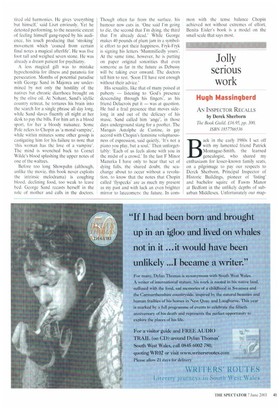Jolly serious work
Hugh Massingberd
AN INSPECTOR RECALLS by Derek Sherborn The Book Guild, i16.95, pp. 300, ISBN 1857766536 Back in the early 1980s I set off with my lamented friend Patrick Montague-Smith, the learned genealogist, who shared my enthusiasm for lesser-known family seats, on a pilgrimage to pay our respects to Derek Sherborn, Principal Inspector of Historic Buildings, pioneer of 'listing' and bachelor squire of Fawns Manor at Bedfont in the unlikely depths of suburban Middlesex. Unfortunately our map
reading went hopelessly awry and we found ourselves proceeding along what looked suspiciously like a runway within the perimeters of Heathrow Airport.
When we eventually arrived at Fawns, Squire Sherborn took us on an expert guided tour of his remarkable treasurehouse. stuffed with fine works of art — or rather slightly less stuffed than hitherto, as he had been subjected to a series of burglaries. Over the most lavish tea I have ever eaten, complete with an abundance of cream cakes and chocolate eclairs, the squire regaled us with horror stories of how he had been tied up at gunpoint with a carrier bag covering his head. Soon afterwards Sherborn moved to Brighton and I lost touch.
So it is a joy to hail this gloriously idiosyncratic memoir by one of the unsung heroes of conservation in this country, now in his 80th year. Although I derived enormous pleasure from the book, I would hesitate to recommend it to those not fascinated by family history and country houses. For An Inspector Recalls is very far from a conventional work of literature. Repetitions, ramblings off the point, exclamation marks and spelling mistakes abound. Excessive detail is lavished upon arcana of exquisite unimportance, while potentially diverting material is frustratingly thrown away. Much of the book is devoted to a barely fleshed-out roll-call of demolished country houses and portions of the text resemble an appointments diary.
Yet such is Sherborn's obsessive passion for his subject that somehow none of this really matters. It is well worth putting up with the occasional longueur when one comes across asides like 'Geoffrey [Sherborn] was the only man in the history of the family since Crecy to have been killed on war service' or It might have been better for me to have had fewer domineering aunts in my life.' And I wouldn't want to have missed such obiter dicta as 'There is nothing wrong with homosexuality ... In the greatest schools in Britain homosexuality is a compulsory subject as part of the study of the Classics', or the intelligence that his visit to La Cage aux FoIles at the Connaught, Worthing, must have been about the 20th time he had seen the show.
The section of the Sherborn family history is enlivened by some eccentric vignettes. An earlier bachelor squire of Fawns stayed in bed for six months a year and had his horse brought upstairs to visit him there. The next squire, another bachelor, was an eminent geologist who lived on dates and described women as 'all cheats'. Derek's father (described as 'a silly man in many ways') looked 'uncommonly like Anthony Eden' and the author speculates that Eden's father, Sir William Eden, may have had an 'arrangement' with his grandmother. The account of his maternal family, shopkeepers in Streatham, where Derek was brought up, provides the sort of object
lesson in social mobility that only the study of genealogy can yield.
As a boy Derek developed a keen eye as a collector; he snapped up a Reynolds for a song. During the second world war, while still in his teens, he carried out, on his own initiative, a street-by-street and house-tohouse investigation of the old buildings of Reading. In 1947 he joined the Ministry of Town and Country Planning as a temporary investigator of historic buildings and three years later he compiled a list of 2,000 outstanding country houses for the Gowers Report, which led to the setting up of the Historic Buildings Councils for England, Wales and Scotland.
The so-called 'national heritage' thus owes Sherborn an immeasurable debt — though, naturally, he has never received any honour. His blistering attacks on the barbaric property developers, philistine politicians, purblind planners and snobbish 'preservation' groups who failed to stop the wholesale destruction of so many historic buildings in the 1950s and 1960s make for instructive reading. Among his targets for some richly entertaining abuse are Sir John Summerson (particularly obstructive and uninterested in preservation'), Tesco (the most destructive of all major developers'), the Baroness Birk ('the most disastrous minister we ever had') and Nicholas Ridley Can absolute fraud). As Sherborn says in one of his priceless asides, 'Anyway it all makes for jolly fun in a way.'











































































 Previous page
Previous page